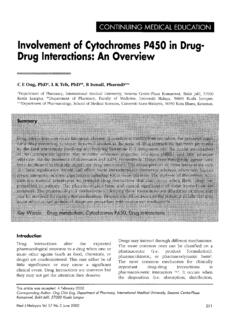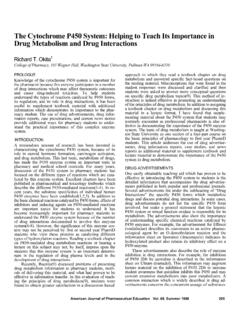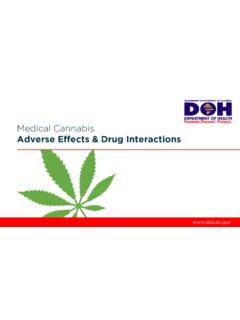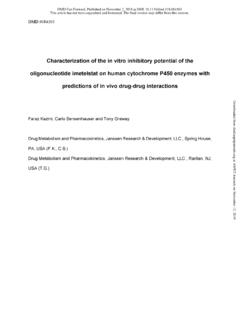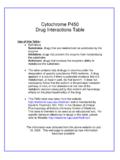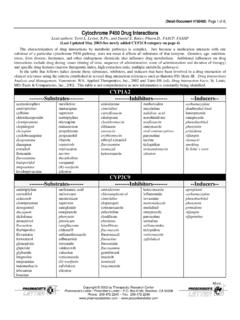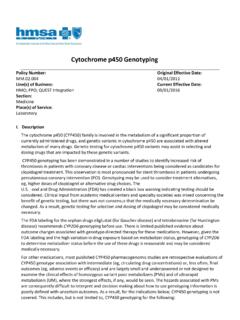Transcription of Nutraceutical-Drug Interaction and CYP450 Pharmacology
1 Nutraceutical-Drug Interaction and CYP450 PharmacologyRodney McKeever,MDUCLA K-30 ProgramINTRODUCTION Plants used as medicines for thousands of yrs Used by all major cultures Saw palmetto used in Egypt in the 15thcentury BC Hippocrates used SJW for mood ailments in the 5thcentury BC The Greek physician Galen (AD 129 200) devised the first pharmacopoeia describing the appearance, properties and use of many plants of his time Herbal medicines flourished in Europe until the 17thcentury declined with the scientific revolution European immigrants brought herbal traditions to America and acquired Native American influences After~1920, standardized synthetic pharmaceutical drugs replaced herbal therapies, felt to have larger pharmacological effects and more profitable Estimated more than 40% of Americans use alternative medical therapies, nutraceuticals (herbals/botanicals) account for a significant proportion >120 conventional drugs derived from plant sourcesExamples of conventional medications with plant originsDrugHerb common name (Latin name)
2 AtropineBelladona (Atropa belladonna)CodeinePoppy (Papaver somniferum)ColchicineAutumn crocus (Colchicum autumnale)DigoxinFoxglove (Digitalis purpurea)EphedrineEphedra (Ephedra sinica)ReserpineRauwolfia (Rauvolfia serpentine)Salicylic acidWillow bark (Salix purpurea)ScopolamineJimson weed (Datura stramonium)TaxolPacific yew (Taxus brevifolia)VincristineMadagascar periwinkle (Catharanthus roseus)Definitions/nomenclature Drugs are substances that alter the body's actions and natural chemical environment A substance used in the diagnosis, treatment, or prevention of a disease or as a component of a are Drugs Though not classified so legally Have pharmacological potency and individualized pharmacokinetics Have a mixture of ingredients, some active, some inactive which yield effects Think about them as drugs and you will have less difficulty in counselingFactors Affecting Bioavailability Physical properties of the drug (hydrophobicity, pKa, solubility Formulation (excipients used, release methods) Relationship to food/meals Interaction with foods grapefruit juice (CYP3A4))
3 , acid/base Gastric emptying rate Circadian differences First-pass metabolism Gut (and brain) transporters ( P-glycoprotein) Individual differences Age, Gender ,GI tract diseasePharmacogenetics of drug metabolism drug metabolism is crucial in determining therapeutic and adverse effects Genetic factors play an important role in individual differences of drug metabolism Phase I Oxidation, reduction, hydroxylation, dealkylation, etc. Aim: introduce a new functional group cytochrome p450 enzymes in hepatocytes attached to SER Phase II Conjugation with glucuronic acid, glutathione, acetate, etc Aim: to increase water solubility Ususally in the cytosolDefinitions/nomenclature Definition of a Nutraceutical: "Food, or parts of food, that provide medical or health benefits, including the prevention and treatment of disease.
4 Dr Stephen DeFelice (Foundation for Innovation in Medicine)-coined the term "Nutraceutical" from "Nutrition" and "Pharmaceutical" in 1989. The term nutraceutical is commonly used in marketing but has no regulatory definition. nutraceutical is an umbrella term in the general vernacular to define herbs, supplements, vitamins or, at times, supplements that are actually illegally used FDA-approved drugs bought for specific uses and may cause severe drug interactions and/or death ( , dextromethorphan products). Dietary supplements-can be extracts or concentrates, and may be found in many forms such as tablets, capsules, softgels, gelcaps, liquids, or powders. These substances may be found in preparations such as fresh decoctions (chopped) or whole herbs (steeped as teas), tinctures (fresh or dried herbs preserved in alcohol), vinegar extracts, syrups, glycerites (in vegetable glycerin), miels (in honey), freeze-dried or powdered (which may come in bulk, tablet, troche, paste, capsule, or concentrate forms), suppositories, creams, gels liniments, oils, or compresses.
5 Functional foods are foods or food ingredients that may have health benefits in addition to providing traditional nutrients such as protein, carbohydrate, vitamins and minerals. Dietary Supplements including botanicals: Vitamins, minerals, co-enzyme Q, carnitine Ginseng, Gingko Biloba, Saint John's Wort, Saw Palmetto Functional Foods: Oats, bran, psyllium and lignin's for heart disease and colon cancer Prebiotics - oligofructose for control of intestinal flora Omega-3 milk in prevention of heart disease Canola oil with lowered triglycerides for cholesterol reduction Stanols (Benecol) in reduction of cholesterol adsorption Medicinal Foods: Health bars with added medicationsNutraceutical Categories:Patients most likely to use Nutraceuticals Middle-aged women Patients with college education Patients with higher income Caucasians Patients diagnosed with cancer The elderly with chronic medical conditions Elderly Hispanic womenReasons for herbal medicine use1 Barnes P, Powell-Griner E, McFann K, Nahin R.
6 CDC Advance Data Report #343. Complementary and Alternative Medicine Use Among Adults: United States, 2002. May 27, of CAM usage It has been estimated that in the United States, 24% of the general population regularly take herbal DW et al: Recent patterns of medication use in the ambulatory adult population of the United States. JAMA (2002) 287:337-344 In 2006, it was found that 63% of US residents over 50 use CAM, and of these, 77% do NOT discuss it with their doctor!AARP (American Association of Retired Persons) and NCCAM. (National Center for Complementary and Alternative Medicine): What people 50 and older are using and discussing with their physicians. Washington DC: AARP 2007 via HerbalGram 75:p15 Use is not limited to the lay public: according to one study in 2003, 84% of pharmacists have tried it(survey in Singapore, but international cohort tested) Khol HL, Teo HH, Ng HL.
7 Pharmacists' patterns of use, knowledge, and attitudes toward complementary and alternative medicine. J. Altern . Comp. Med. (2003) 9(1):51-63 Although many recommend CAM products, they admit that they consider their expertise in this area to be inadequate Welna EM et al Pharmacists' personal use, professional practice behaviors , and perceptions regarding herbal and other natural products. J Am Pharm Assoc. (2003) 43(5):602-11 Case Report62 y/o male h/o CLL presents with 3D h/o fatigue, SOB, fever and cough; Rx with chemotherapy for 3 mos PTAMeds: valproic acid (1500mg ) for post-traumatic sz disorderAdm: orientedX4; hypoxic (PO256mmHg on 21%)Normocapnic (PCO237mmHg)CXR-B/L Pneumonia involving inferior lobesHospital course: bronchalveolar lavage with yeast no PCP (Pneumocystis carinii) ATBx with Ceftriaxone, Clarithromycin and Voriconazole Codeine 25mg given for cough HD#4 LOC with unresponsiveness; last dose of codeine 12h prior to in mental status ABG PO2 56mmHg PCO2 80 mmHg on 50% Rx with noninvasive ventilation (NIV) transferred to ICU GCS 6 (E=1;V=1.)
8 M=4 withdraws to noxious stimuli) pupils pinpoint, no focal deficits noted Repeat ABG post-NIV therapy PO2 68mmHg/PCO2 56mmHg BUN/Cr levels(45mg/dL/ ) BUN/Cr normalized with hydration valproic acid and ammonia levels WNL IV naloxone ( ) givenX 2doses resulted in dramatic LOC Placed on naloxone infusion resulting in normal LOC and resolution of respiratory failureDisposition: 2D post acute event complete recoveryAt the time of the pt s coma: plasma morphine was 80 g/L (normal 1-4 g/L) morphine-3-glucuronide was 580 g/L (normal 8-70 g/L) morphine-6-glucuronide was 136 g/L (normal 1-13 g/L ) CYP2D6 genotyping : ultra rapid metabolismN Engl J Med 2004;351:2827-31 Codeine is a Substrate of CYP2D6 Consider the variation in codeine s metabolism among PM, IM, EM, UM individuals-CH3(methyl morphine)Hepatic metabolism of MorphineONCH3 OHOOOHOHOHCOOM orphineGlucuronateMorphine + UDP-glucuronideMorphine-glucuronide + UDPU rine, bileGlucuronidation renal eliminationMorphine-6-glucuronide (potent analgesic)Morphine-3- glucuronide (excitatory side-effect) DemethylationNormorphine (excitatory side effects)CYP3A4 (grapfefruit juice), CYP2C8 (quercetin)Morphine MetabolismCytochrome p450 Enzymes Group of heme containing enzymes responsible for phase 1 oxidative metabolic reactions Family that detoxify compounds Absorbance of light at 450 nanometers (hence CYP450 )
9 On membranes of endoplasmic reticulum in liver, gut, brain, lung, kidneyCYP Nomenclature Nomenclature of CYP genes: Arabic number for gene family Capital letter for gene subfamily Arabic number for individual gene CYP enzymes of different gene families have a 40% or more homology in their amino acid sequences, but enzymes within one subfamily may have different substrates, regulation, etc. Over 70 % of total CYP content of the human liver is shared by seven subfamilies: CYP1A2, CYP2A6, CYP2B6, CYP2C, CYP2D6, CYP2E1, CYP3A Extent of metabolism is determined by Affinity of substrate-enzyme complex Relative abundance of a given CYP enzyme relative to the total CYP contentCytochrome p450 Nomenclature, for CYP2D6 CYP = cytochrome p450 2 = genetic family D = genetic sub-family 6 = specific gene NOTE that this nomenclature is genetically based: it has NO functional implicationOverview continued: At LEAST 50 (57) isoenzymes, grouped based on their sequences Example: CYP3A4.
10 cytochrome p450 , family 3 , subfamily A and the 4thenzyme in the subfamily Most CYP-450 enzymes involved in drug metabolism belong to the three distinct families, CYP1, CYP2 and CYP3 (50% of all drugs) Some drugs processed by several CYP450 isoenzymesCytochrome p450 Shimada T et Pharmacol Exp Ther1994;270(1):414. CYP3 ACYP2D6 CYP2 CCYP1A2 CYP2E1 Relative Importance ofP450s in drug MetabolismCYP3 ACYP2 CCYP1A2 CYP2E1?CYP2D6 Relative Quantities of P450s in LiverCYP450 Cytochrome P450s (CYPs) Genetic variants are associated with altered drug levels, but not with disease CYP2D6: 25% of drugs CYP2C9: 5% CYP2C19: 15% CYP3A4: 50% drug interactions (Liver)CYP SubstrateCYP InhibitorCYP SubstrateCYP Inducer Substrate concentration Substrate concentration Toxicity EfficacyInducers and Inhibitors: An overwhelming subject information overload!
